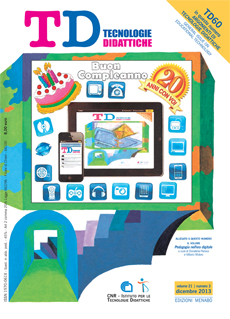Powerpoint lessons: do students read or listen?
Main Article Content
Abstract
Article Details
Section
Authors who publish with this journal agree to the following terms:
- Authors retain copyright and grant the journal right of first publication with the work simultaneously licensed under a Creative Commons CC BY 4.0 Attribution 4.0 International License.
- Authors are able to enter into separate, additional contractual arrangements for the non-exclusive distribution of the journal's published version of the work (e.g., post it to an institutional repository or publish it in a book), with an acknowledgement of its initial publication in this journal.
- Authors are permitted and encouraged to post their work online (e.g., in institutional repositories or on their website) prior to and during the submission process, as it can lead to productive exchanges, as well as earlier and greater citation of published work (See The Effect of Open Access)
References
Adesope O.O., Nesbit J.C. (2012). Verbal redundancy in multimedia learning environments: A meta-analysis. Journal of pp. Educational Psychology, 104, pp. 250-263.
Antonietti A., Colombo B.(2008). Computer-supported learning tools: A bi-circular bi-directional framework. New Ideas in Psychology, 26, pp. 120-142.
Apperson J., Laws E., Scepansky J. (2008). An assessment of student preferences for powerpoint presentation structure in undergraduate courses. Computers and Education. 50, pp. 148-153.
Ausubel D. (1962). A subsumption theory of meaningful verbal learning and retention. Journal of General Psychology, 66, pp. 213- 214.
Bartsch R. Cobern K. (2003). Effectiveness of PowerPoint presentations in lectures. Computers Education, 41, pp. 77-86.
Bobis J., Sweller J., Cooper M. (1993). Cognitive load effects in a primary-school geometry task. Learning and Instruction, 3, pp. 1-21.
Brasel S., Gips J. (2011). Media multitasking behavior: concurrent television and computer usage. Cyberpsychology, Behavior, and Social Networking, 9, pp. 527-534.
Cantoia M., di Nuzzo C., Puglisi G., Scioli S., Serino S. (2011). I materiali didattici in Power Point: studenti e docenti a confronto. In Atti del IV convegno nazionale di Didattica della Psicologia (Facoltà di Psicologia, dell’Università degli Studi di Padova 25 - 26 febbraio 2011). http://convdidattica.psy.unipd.it/ (ultima consultazione 04.10.2013)
Chandler P., Sweller J. (1992). The split-attention effect as a factor in the design of instruction. British Journal of Educational Psychology, 62, pp. 233-246.
Chandler P., Sweller J. (1991). Cognitive load theory and the format of instruction. Cognition and Instruction, 8, pp. 293-332.
Clark R., Mayer R (2002). E-Learning and the Science of Instruction: Proven guidelines for consumers and designers of multimedia learning. Hoboken, NJ, USA: John Wiley Sons.
Farkas D. (2005). Understanding and using Power Point. Proceedings of the STC Annual Conference: Usability and Information Design, pp. 313-20.
Farkas D. (2006). Toward a better understanding of PowerPoint deck design. Information Design Journal + Document Design, 14 (2), pp. 162- 171.
Kalyuga S., Chandler P., Sweller J. (1999). Managing split-attention and redundancy in multimedia instruction. Applied Cognitive Psychology, 13, pp. 351–371.
Le Bohec O., Jamet E. (2008). Levels of verbal redundancy, note-taking and multimedia learning. In J. Rouet, R. Lowe, W. Schnotz (eds.). Understanding Multimedia Documents. New York, NY, USA: Springer, pp. 79-101.
Mayer R. (2001). Multimedia Learning. Cambridge, UK: Cambridge University Press.
Mayer R. (2005). The Cambridge handbook of Multimedia Learning. New York, NY, USA: Cambridge University Press, pp 159-167.
Mayer R., Johnson C. (2008). Revising the redundancy principle in multimedia learning. Journal of Educational Psychology, 2, pp. 380-386.
Media Management Center (2009). Teens know what they want from online news: Do you?. Arlington, VA, USA: API. http://www.americanpressinstitute. org/Research/Foundation/Youth- Content/Teens-Know-What-They-Want-From- Online-News.aspx (ultima consultazione 04.10.2013).
Moreno R., Mayer R. (2002). Verbal redundancy in multimedia learning: when reading helps listening. Journal of Educational Psychology, 92, pp. 724-733.
Ozuru Y., Kurby C., McNamara D. (2012). The effect of metacomprehension judgement task on comprehension monitoring and meta cognitive accuracy. Metacognition Learning, 7, pp. 113-131.
Paoletti G., Rigutti S. (2009). Efficacia di testi e presentazioni PowerPoint nella didattica Universitaria. In Domenici G., Semeraro R. (eds.). Le nuove sfide della ricerca didattica tra saperi, comunità sociali e culture. Roma, IT: Monolite.
Paoletti G., Rigutti S. (2010). Come presentare la tesi di laurea. Con PowerPoint, Impress, Google.docs i lucidi, la lavagna…. Roma, IT: Carocci.
Paoletti G., Bortolotti E., Zanon F. (2012). Effects of redundancy and paraphrasing in university lessons. Multitasking and cognitive load in writtenspoken PowerPoint presentation. In IJDLDC, 3 (3), Luglio-Settembre, pp. 1-11.
Paoletti G. (2012). Writing with Powerpoint. In D. Alamargot, M. Castelló, R. Llull, F. Ganier , O. Kruse, A. Mangen, L. Tolchinsky, L. Van Waes (eds.). Learning to write effectively: current trends in European Research. Bingley, UK: Emerald, pp. 325-327.
Sweller J. (2005). The redundancy principle in multimedia learning. In R. E. Mayer (ed.). The Cambridge handbook of Multimedia Learning. New York, NY, USA: Cambridge University Press, pp 159-167.
Tufte E. (2003). PowerPoint is Evil. On Newsstands Now, Issue 11.09. http://www.wired.com/wired/archive/11.09/ ppt2.html (ultima consultazione 06.09.2012).

